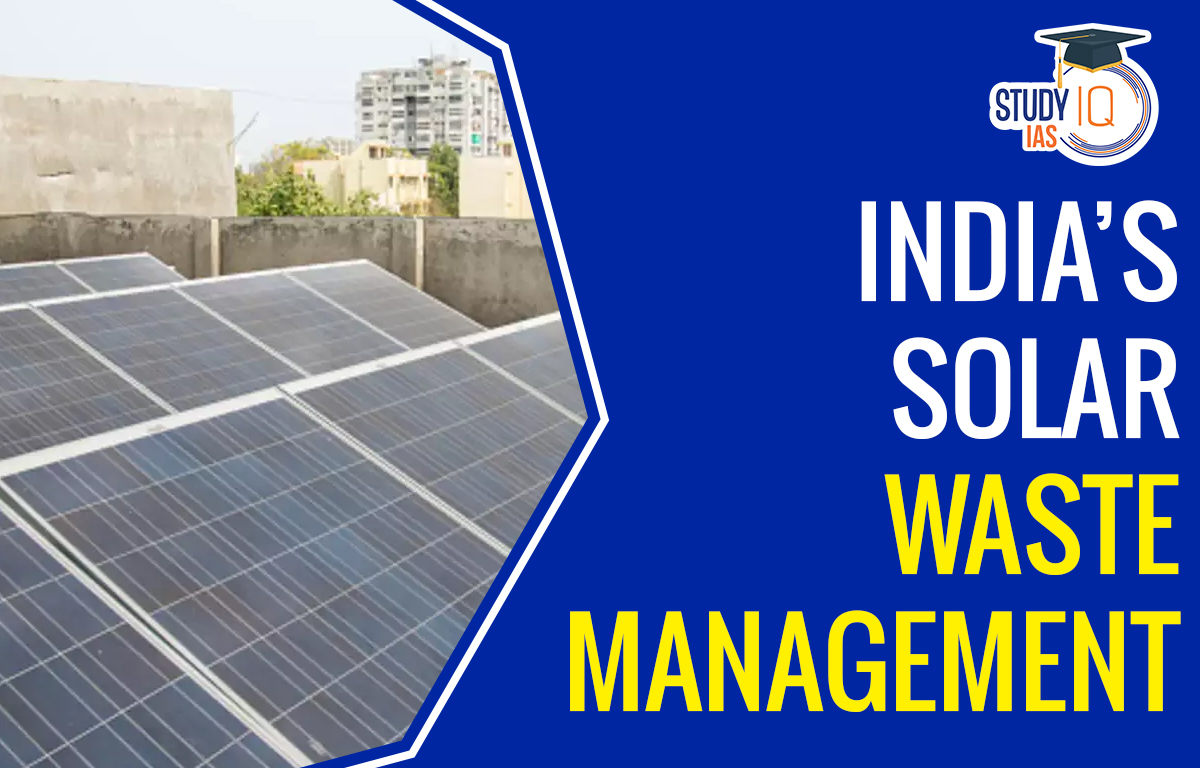Table of Contents
Context: India needs concerted efforts towards waste management in the solar photovoltaic (PV) sector.
What is Photo Voltaic Waste?
- It is the electronic waste (e-waste) generated by discarded solar panels and Photo-voltaic (PV) devices.
- Photovoltaic (PV) devices contain semiconducting materials that convert sunlight into electrical energy.
- A single PV device is known as a cell, and these cells are connected in chains to form larger units known as modules or panels.
- Although up to 90% of the components are recyclable, many PV modules contain heavy metals such as cadmium, copper, lead, antimony or selenium, and when they are taken out of service or broken, they may be classified as hazardous waste.
Solar Photo Voltaic Waste in India
- Solar PV Deployment: India has the world’s fourth highest solar PV deployment.
- The installed solar capacity was nearly 62GW in November 2022. This will lead to huge amount of solar PV waste in India.
- India has ambitious solar target of 280 GW by 2030.
- NSEFI Report: According to a report by the National Solar Energy Federation of India, India could generate over 34,600 tonnes of cumulative solar waste by 2030.
- IRENA Report: According to the International Renewable Energy Agency, India is expected to be one of the top five photovoltaic-waste creators by 2050.
- Recycling in India: When the photovoltaic panels reach their end of lives, some portions of the frame are extracted and sold as scrap in India.
- Junctions and cables are recycled according to e-waste guidelines.
- The glass laminate is partly recycled.
- Rest is disposed of as general waste.

Solar Photo Voltaic Waste in India
- Solar PV Deployment: India has the world’s fourth highest solar PV deployment.
- The installed solar capacity was nearly 62GW in November 2022. This will lead to huge amount of solar PV waste in India.
- India has ambitious solar target of 280 GW by 2030.
- NSEFI Report: According to a report by the National Solar Energy Federation of India, India could generate over 34,600 tonnes of cumulative solar waste by 2030.
- IRENA Report: According to the International Renewable Energy Agency, India is expected to be one of the top five photovoltaic-waste creators by 2050.
- Recycling in India: When the photovoltaic panels reach their end of lives, some portions of the frame are extracted and sold as scrap in India.
- Junctions and cables are recycled according to e-waste guidelines.
- The glass laminate is partly recycled.
- Rest is disposed of as general waste.
Key Issues in India’s Solar Waste Management
- No Segregation: India currently considers solar waste a part of electronic waste and does not account for it separately.
- No Clear Policy: While India ramps up its solar power installation, it does not yet have a firm policy on managing waste that results from used solar panels or from the manufacturing process.
- Dumping in Landfills: Only about 20% of the PV waste is recovered in general; the rest is treated informally. As a result, the waste often accumulates at landfills.
- Expensive Recycling: The process of recycling PV waste is expensive and time-consuming, hence the companies find it better to dispose of the dead panels in landfills or export them to third-world countries.
- Environmental Danger: Landfill disposal of PV waste causes acidification, leaching of toxic metals (such as lead and cadmium) into the soil. It also contaminates the local water.
- Gradual incineration of the panel encapsulant also releases sulphur dioxide, hydrogen fluoride, and hydrogen cyanide into the atmosphere.
- Lack of Policy measure: The market to repurpose or reuse recycled photovoltaic waste in India is minuscule.
- There is a lack of suitable incentives and schemes in which businesses can invest.
- There is no regulatory body to measure, monitor, and report solar photovoltaic waste too.
Solar PV Waste Management in Other Countries
- EU: The European Union’s ‘Waste Electrical and Electronic Equipment Directive’ makes producers responsible for safely and responsibly disposing of end-of-life photovoltaic panels.
- US: States have the freedom to establish their own solar photovoltaic regulatory standards.
- Its National Renewable Energy Laboratory is also exploring ways to boost the circular economy in the solar photovoltaic sector.
- Japan: Manufacturers in Japan are responsible for developing environment-friendly recycling technologies through public-private partnerships.
- China: China has introduced an implementation plan for life-cycle management and to improve the resource efficiency of solar photovoltaic panels.
- Chinese researchers are also developing recycling processes to recover silicon from end-of-life panels and process them back into solar wafers.

Solutions to India’s Solar Waste Management
- Clear Provisions: India should formulate and implement provisions specific to photo-voltaic waste treatment within the ambit of the e-waste guidelines.
- Legislative Framework: The Government should also build a legislative framework to enforce the Extended Producer Responsibility Rules.
- Regulatory Body: A Central insurance or a regulatory body should be set up to protect against financial losses incurred in waste collection and treatment.
- Awareness Programmes: There needs to be pan-India sensitization drives and awareness programmes on photovoltaic waste management.
- Clear Recycling Targets: Clear recycling targets and recycling rates in the photovoltaic waste management can be a helpful initiative.
- Domestic Technologies: The domestic development of photovoltaic waste recycling technologies must be promoted through suitable regulatory incentives, recycling programmes, appropriate infrastructure facilities, and adequate funding.
Way Forward
- The latest production-linked incentive scheme in India promotes the domestic manufacturing of high-efficiency solar photovoltaic modules.
- Considering the rate at which these panels are being installed around the country, India is expected to generate an enormous amount of waste over the next 15-20 years.
- Hence, it is imperative to install clear policy directives, well-established recycling strategies, and greater collaboration, so that PV waste doesn’t create a problem in future.


 TNPSC Group 4 Admit Card 2025 Out at tnp...
TNPSC Group 4 Admit Card 2025 Out at tnp...
 Species Added to India's Flora and Fauna...
Species Added to India's Flora and Fauna...
 Daily Quiz 02 July 2025
Daily Quiz 02 July 2025





















